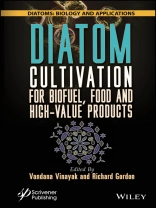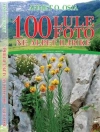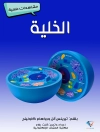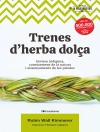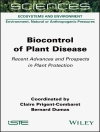This unique book examines the techno-economic prospects of diatom cultivation, the design and implementation of algal reactors, and the potential of diatoms as a source of biofuel and other value-added products.
Diatom Cultivation for Biofuel, Food and High-Value Products covers the scientific, economic, and practical aspects of using diatoms for multiple purposes. It explores an integrated approach to diatom cultivation, including discussions on techniques, harvesting methods, and innovative technologies. The book discusses the potential of these techniques for improving the efficiency and yield of diatom-based biofuels, as well as the challenges and ethical considerations associated with genetic engineering.
Readers of the book will discover a wealth of information including:
- The adaptation of chitosan-based harvesting methods for microalgae flocculation; the trends, scope, and techno-economic prospects of diatom cultivation, including the design and implementation of algal reactors and the potential of diatoms as a source of biofuel and other value-added products.
- Advanced applications and innovative techniques in the field of diatoms and microalgae such as an in-depth analysis of the pigments and proteins found in Phaeodactylum tricornutum; the nature and applications of diatom cell walls, including their purification processes and industrial uses; the biochemical engineering of diatoms for health and biorefinery concepts, highlighting the potential of diatoms in producing biofuels and other high-value products; the metabolic and transcriptomic stress and engineering of diatoms to enhance lipid production, exploring the stress conditions that can increase oil yield; explores the genetic engineering techniques, such as CRISPRCas9 and RNA interference.
- The environmental and industrial applications of diatoms for low-value products, such as diatom as a prospective green anode material; diatom cell disruption and milking via a nano biorefinery for biofuel production, utilizing techniques like pulsed electric fields, high-pressure homogenization, ultrasonication, etc; genetic engineering and metabolic engineering in diatoms for oil production; the use of diatoms for heavy metal bioremediation, exploring the mechanisms of heavy metal uptake by diatoms, including biosorption and bioaccumulation; the transesterification of diatom oil and parameters for optimization; diatom harvesting for lipid production like bubble wrap (Bubble Farming).
Audience
The book serves as a guide for researchers and scientists in phycology, biology, ecology, environmental science, biofuels, bioengineering as well as nutritionists and dieticians who design functional foods and nutraceutical products.
表中的内容
Preface xv
Acknowledgements xix
Part I: Culture Methods 1
1 Adaptation of Chitosan-Based Harvesting Methods for Flocculation of Microalgae 3
Mainavi Patel, Hirak Parikh and Gayatri Dave
1.1 Microalgae 4
1.2 Microalgae Cultivation and Challenges 4
1.3 Microalgae Harvesting: Technological Limitations and Needs 6
1.4 Harvesting Methods 7
1.5 Chitosan as Natural Flocculant 9
1.6 Chitosan in Conjunction with Other Physicochemical Methods 12
1.7 Comparison of Different Harvesting Methods 15
1.8 Conclusion 15
2 Diatoms Cultivation: Trends, Scope and Technoeconomic Prospects 21
Anshuman Rai, Nirmala Sehrawat, Mukesh Yadav, Varruchi Sharma, Vikas Kumar and Anil K. Sharma
2.1 Introduction 22
2.2 Cultivation Strategy and Production 24
2.3 Design and Implementation of a Prototype Algal Reactor 27
2.4 Potential of Diatoms as a Source of Biofuel with Value-Added Products 29
2.5 Industrial Aspects of Diatoms as a Source of Biofuel 31
2.6 Economic Feasibility Assessment 32
2.7 Biochemical Composition 33
2.8 Feedstock Availability Assessment 37
2.9 Scope of Diatoms in Biorefinery 38
2.10 Conclusions and Future Prospects 39
3 Biochemical Compounds in Phaeodactylum tricornutum 51
Vandana Sirotiya and Vandana Vinayak
3.1 Introduction 52
3.2 Biochemical Compounds 59
3.3 Demand, Valorization and Biotechnological Applications 66
3.4 Conclusion 68
Part II: High-Value Products 79
4 Diatoms: A Natural Resource of High-Valued Products and their Future Prospective 81
Khushboo Kesharwani, Shruti Sharma, Aanand Kautu, Satyendra Kumar Tripathi, Vikas Kumar and Khashti Ballabh Joshi
4.1 Introduction 82
4.2 Biosilicification and Silicification as a Crucial Application in Bone Repair 89
4.3 Effect of Metals as a Therapeutic Application on Diatom Frustules 90
4.4 Successful Deposition of Metals on Diatom Frustules 91
4.5 Biomedical and Environmental Applications 92
4.6 Deposition of Different Metal Nanoparticles for Various Applications 94
4.7 Interaction of Diatoms with Peptides and Their Plausible Applications 100
4.8 Diafuel: A Diatom Application with the Most Potential 101
4.9 Conclusion 102
5 Diatom Cell Wall: Nature Engineered Nanostructures 115
Sakshi Phogat, Rashi Tyagi, Abhishek Saxena, Pankaj Kumar Singh and Archana Tiwari
5.1 Introduction 116
5.2 Nature of Diatom Cell Wall 117
5.3 Purification of Diatoms 121
5.4 Nutritive and High-End Product 122
5.5 Biofuel Industry 126
5.6 Factors of Diatom for Producing Biofuel 126
5.7 Biomedical Industry 127
5.8 DE Silica for Tissue Engineering 127
5.9 Nanotechnologically Derived Smart Drug Delivery System 128
5.10 Future Perspective 132
5.11 Conclusion 132
6 Biochemical Engineering of Diatoms for Health Benefits 139
Rishabh Rathore, Pragati Verma, Sonali Raghdale, Avishek Kumar, Mohd Jahir Khan and Vandana Vinayak
6.1 Introduction 140
6.2 Chemical Composition of Diatom Biomass 142
6.3 Microalgae as Hidden Treasure of Novel Drugs for Good Health 146
6.4 Microalgal Drugs in Preventing Viral Pandemics 153
6.5 Conclusions 156
7 Metabolism and Transcriptome Stress in Diatom Phaeodactylum tricornutum for Value-Added Products 167
Urvashi Soni, Sonali Rahangdale, Megha Mourya and Vandana Vinayak
7.1 Introduction 168
7.2 Commercial Market Value 170
7.3 Metabolic Pathways and Mechanisms for Synthesis of High Value Added Products in Diatoms 173
7.4 Light Stress in Diatoms and Fucoxanthin Biosynthesis 179
7.5 Transcriptomics in Diatoms 186
7.6 Conclusions 189
8 Terraforming Mars with Microalgae, Especially Diatoms 203
Ira Rai, Jackson Achankunju, Richard Gordon and Vandana Vinayak
8.1 Introduction 204
8.2 Instrumentation to Artificially Simulate Life on Mars 206
8.3 Diatoms for Long-Term Space Missions 211
8.4 Potential Diatoms for the BLSS: Taxa Tolerant to Extreme Conditions 212
8.5 Testing Diatom Growth Under Microgravity Conditions 217
8.6 Life Support Systems for Space Missions 220
8.7 Management of the Culture Vessel and Elements 222
8.8 Conclusions 223
9 Diatom: Source of Biofuel and Active Green Anode Material for Advanced Energy Storage Application 231
Vivek Dalvi, Sumit Dhali and Anushree Malik
9.1 Diatoms — Microalgae with Unique Structure and Properties 232
9.2 Biofuel Application 234
9.3 Diatom Silica: Material for Li-Ion Battery Anode 237
9.4 Conclusion 239
Part III: Low-Value Products 245
10 Milking of Diatoms: A Realistic Approach to Serve the Biorefinery Concept 247
Mrinal Kashyap
10.1 Introduction 248
10.2 Cell Disruption Methods 250
10.3 Concept of Milking Cells for Value-Added Compounds 254
10.4 Economic Perspectives of Biofuels and Cell Disruption 257
10.5 Prospects and Challenges of the Milking Process 259
10.6 Conclusions 260
11 Dissection of Gene Expression Pattern and Metabolic Profile Under Enhanced Oil Production Conditions in Diatoms 267
Geetanjali Kumawat, Pallavi Vyas, Sandhya Deora, Sneha Sabu, Amit Kumar Gupta, Mukesh Meena, Ashwani Kumar, Vandana Vinayak and Harish
11.1 Introduction 269
11.2 Generalized Pathway for Lipid Biosynthesis in Diatoms 276
11.3 Stress Conditions (Metabolites) Helping to Increase Oil Production 278
11.4 Changes in Gene Expression in Diatoms During Stress Conditions 290
11.5 Structural and Functional Aspect of Candidate Genes/Enzymes of Lipid Biosynthesis Pathway 294
11.6 Role of r DNA Technology in Improving Diatom Strains for Enhanced Lipid Production 297
12 Implications of Diatoms for Heavy Metal Bioremediation 323
Varad Nagar, Vinay Aseri, Rushikesh Chopade, Pritam P. Pandit, Badal Mavry, Apoorva Singh, Garima Awasthi, Kumud Kant Awasthi and Mahipal Singh Sankhla
12.1 Introduction 324
12.2 Mechanism for Heavy Metal Removal by Diatoms 326
12.3 Bioremediation and Biosorption of Heavy Metals 326
12.4 Challenges 328
12.5 Advantage of Diatoms Over Other Techniques and Algae 329
12.6 Production of Diatoms on a Commercial Scale and Its Application 329
12.7 Future Aspects 333
12.8 Conclusion 334
13 Optimizing Bioenergy from Diatoms through Biofilms 341
G. Saranya and T.V. Ramachandra
13.1 Introduction 342
13.2 Different Configurations of Biofilm Cultivation Systems 344
13.3 Surface Materials for Biofilm Cultivation 345
13.4 Microalgal Biorefinery 365
13.5 Conclusion and Future Perspectives 366
14 Diatoms Characteristics and Mass Processing of Lipids for Biofuel Production 377
Tawaf Ali Shah, Zhihe Li, Zhiyu Li and Andong Zhang
14.1 Diatoms 378
14.2 Reproduction 379
14.3 Ecology and Distribution 379
14.4 Morphology and Identification 381
14.5 Diatom Age, Diversity and Ecological Functions 381
14.6 Biofuel Production and Types of Biofuels 383
14.7 Different Methods of Lipid Extraction for Biofuel 390
14.8 Benefits of Diatoms 393
14.9 Genetic Engineering and Metabolic Pathway Engineering 393
14.10 Future Prospects 394
14.11 Conclusion 395
Acknowledgment and Funding 396
Data Availability 396
References 396
Index 399
关于作者
Vandana Vinayak is an assistant professor in the School of Applied Sciences, Dr. Hari Singh Gour Vishwavidhyalaya University, Sagar, Madhya Pradesh, India. Her research focuses on diatom nanoengineering, sustainable algal technologies, and valorization. She has published more than 50 research articles, 20 review articles, 12 book chapters, and two published patents. Vinayak has won the Women Scientist Award and the Noel Gold Medal Award.
Richard Gordon involvement with diatoms goes back to 1970, when his capillarity model for their gliding motility was published in the Proceedings of the National Academy of Sciences of the United States of America. He later worked on a diffusion-limited aggregation model for diatom morphogenesis, which led to the first paper ever published on diatom nanotechnology in 1988. He organized the first workshop on diatom nanotech in 2003.
